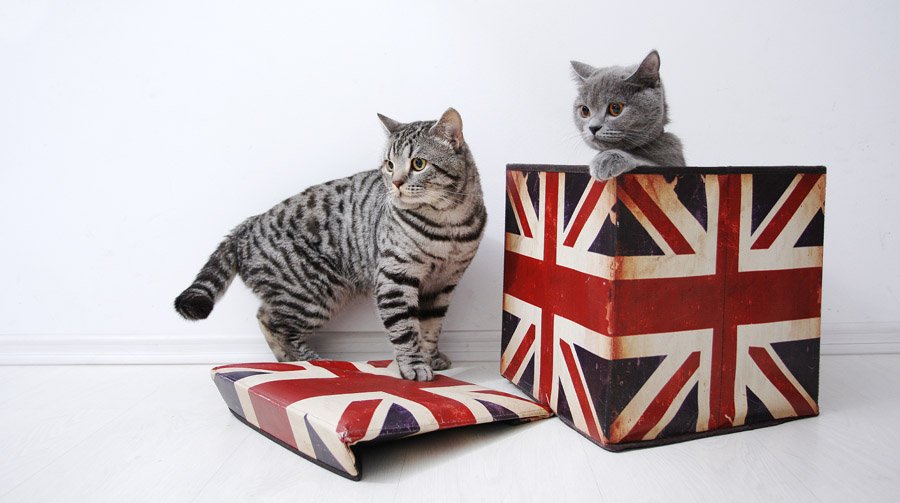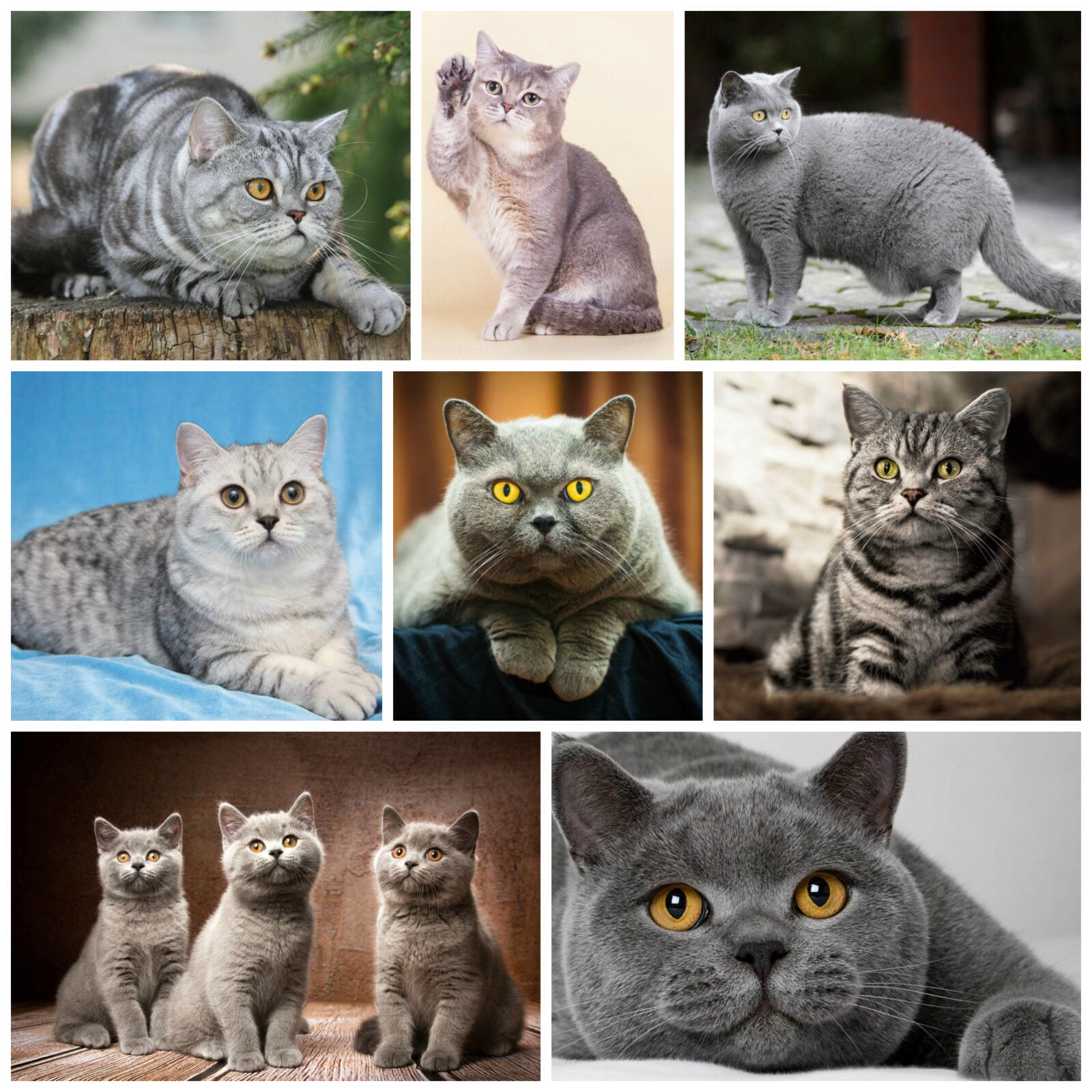
Brief description of the breed
The British Blue was bred around the end of the nineteenth century. In the process of selection, the color of the animal has changed, so the name has become not entirely relevant. In this regard, representatives of the breed began to be called "British Shorthair". To date, there are more than a hundred variations of the color and pattern of these cats.
Officially, the British Shorthair is described as a strong pet, with a strong, stocky body, short legs, a round head, small, wide-set ears and a short, straight nose.
The short coat, similar to plush with a characteristic undercoat, helps the animal to keep warm on cool days. The coat color and pattern variations of this breed are the richest. Hair can have almost any shade: white, black, blue, red, cream, chocolate, purple. There may be cats whose coat has a two-color or three-color color.
The color of the eyes may also be different. It will depend on the coat color of the animal. Many consider white British Shorthair cats to have the most gorgeous eye color. These pets have deep sapphire eyes. The eyes can also be dark gold, copper, or orange. It is noteworthy that among the representatives of the breed, animals with multi-colored eyes are quite common.
basic information
| Breed name: | british shorthair cat |
| Country of origin: | United Kingdom |
| The time of the birth of the breed: | 19th century |
| The weight: | 3 - 8 kg |
|
EMS code:
|
B.R.I. |
| Life Expectancy: | 12 - 15 years old |
| Price kittens: | 100 – 700 $ |
| Most popular nicknames: | list of nicknames for british shorthair cats |
Assessment of breed characteristics
|
Adaptability
(A definition that means how easily a cat can adapt to changes in life)
|
🐱🐱🐱🐱🐱 |
|
Shedding level
(Level and frequency of hair loss in the animal)
|
🐱🐱🐱🐱 |
|
Tenderness level
(The level and amount of tenderness and affection that the cat gives in return for attention to itself)
|
🐱🐱🐱🐱🐱 |
|
Social need
(The required number of contacts of a cat with other animals, as well as people)
|
🐱🐱🐱 |
|
Grooming
(The number of bathing, brushing, and the number of professional grooming sessions required for the cat)
|
🐱🐱 |
|
Friendliness in an unfamiliar environment
(Features of the cat's behavior in a society with strangers or in an unfamiliar environment)
|
🐱🐱 |
|
Health issues
(Potential health status of a cat)
|
🐱🐱 |
|
Intelligence
(The ability of a cat to think and solve emerging difficulties)
|
🐱🐱🐱 |
|
Friendliness to children
(A factor that determines how friendly a cat is to children, whether she likes to play with them and tolerate some childish pranks)
|
🐱🐱🐱🐱 |
|
Game activity
(The concept is determined by its very name, and, as a rule, is found in almost all cats)
|
🐱🐱 |
|
Dog friendly
(The cat's tendency to get along with dog)
|
🐱🐱🐱🐱🐱 |
Photo of a British shorthair cat:

History of the British Shorthair
The breed was bred in the nineteenth century. She gained popularity among British pet lovers almost immediately. They could be found in many houses, on farms and just on the street. The appearance of the breed in foggy Albion is associated with the invasion of the Roman conquerors, who brought the ancestors to the territory of the kingdom.
It is believed that the breed originally appeared due to the crossing of local animals with cats of European varieties, which are distinguished by strong muscles. At an exhibition held at the British Crystal Palace in 1871, the British Shorthair became the most popular breed. At that time, representatives of this breed were considered the most fashionable. cats Britain.
However, at the turn of the nineteenth and twentieth centuries, the breed began to decline. In the late 1800s and early 1900s, almost no one was engaged in the selection of the British Shorthair. As a result, the number of representatives of the breed began to decline rapidly. By the beginning of the fifties of the last century, the breed had practically disappeared. It was also associated with the appearance new cat breeds, which interested most breeders, and the British Shorthair went not even into the background, but into the background.
The situation was saved by a group of breeders who decided to take action to save the breed. Unfortunately, selection by crossing purebred representatives of the breed has become almost impossible due to their small number. The decision was made to breed existing British Shorthairs with males. persian breed, as well as with cats that look like British Shorthairs.
As a result, pets appeared that were somewhat different from those that were considered the standard. Such visual differences were the reason for the long rejection of the official recognition of newly bred cats and classifying them as British Shorthairs. But a few years later, nevertheless, these animals were classified as representatives of the breed. A new stage in the development of British Shorthair cats has begun.
Personality of the British Shorthair cat
The British Shorthair is often described as a calm and unobtrusive animal, with a fairly independent character. Despite this, representatives of the breed love to be among family members and take part in all family activities.
This is not to say that British Shorthairs are affectionate pets. It should be noted that these cats are very selective. Unlike many other breeds, this cat will not go to the hands of the first comer, and the pet is unlikely to be happy to communicate with strangers. The cat likes to sit in the arms of only those people whom she has chosen herself.
The British Shorthair cat is not very demanding of itself in terms of care and attention. In this regard, it is considered to be an excellent option for busy people who spend most of their time at work. These cats will appreciate the company of another pet if they stay alone at home for a long time.
Despite such an extraordinary character, short-haired British are quite tolerant of children. Kittens of this breed, like most young animals of other breeds, are playful and active, but in the process of growing up they become less mobile, instead of active games, they increasingly choose the opportunity to just lie down or take a nap. Even when alone for a long time, the British shorthair cat does not show much activity, so your furniture or decor items are unlikely to be damaged.
Maintenance and care
Feeding
In principle, British shorthair cats are not particularly picky. They will be happy to eat specialized dry and canned food. At the same time, one should not forget about the need to systematically add boiled chicken, ham, and cheese to the pet's diet. Due to the fact that cats of this breed generally lead a passive lifestyle, care should be taken to ensure that the pet does not gain excess weight. Otherwise, the animal may be threatened with obesity. This problem is especially relevant for neutered cats. Experts say that a short-haired British cat needs to receive 70 kilocalories per 1 kilogram of weight per day. It must be understood that certain foods should not be included in the diet of the animal. For example, cow's milk, which can cause indigestion.
Health and disease
Some interesting facts
- The British Shorthair is one of the oldest and one of the largest cat breeds in the UK.
- There are more than a hundred variations in the color and pattern of the coat of cats of this breed, the color of the eyes also varies, which largely depends on the color of the coat.
- British Shorthair cats have a wayward and fairly independent character. They are not particularly willing to make contact with strangers, and they accept caresses and strokes only from the closest people.
- Cats This breed is good with children.
- Although British Shorthairs are very active as children, they become more passive as they age.
- British Shorthair can be purchased even for those people who have little free time, and they spend most of the day at work. Loneliness does not particularly affect the character of the animal.
- Cats of this breed are unpretentious in nutrition, but they are prone to obesity. It is necessary to follow an appropriate diet and not overfeed the animal.
- British Shorthair cats are considered healthy animals. The most common diseases are infectious in nature. Their occurrence can be prevented with the help of timely vaccinations.
- Caring for a cat of this breed is very simple, so the British Shorthair is perfect for a beginner.
Nurseries and breeders
We borrowed material from the wonderful site of our partners DOGCATFAN.COM about cats and dogs, the author dogcatfan
